A newcomer in destroyer design
WW2 Japanese destroyers were certainly among the world’s most powerful since the Fubuki in 1926. Just like Russia showed the way in 1910 with the Novik, Japan was at the forefront in destroyer design, with speed, firepower, and aggressive tactics matching over-the-top torpedoes like the deadly “long-lance”. The prewar models were rather small, high seas TBs, while from 1917, Japan launched in a frenzy dozens of large oceanic destroyers. This story started very early on, like many other nations, with torpedo-boats. In August 1914, 62 destroyers were in service, all classes confounded.

Destroyer Momo in the Mediterranean, 1917. src: Roads to the Great War – blogger
From 1879 to 1895
The first contract on behalf of the IJN was awarded as early as 1879. Because of previous events, little funds, only small series of modest ships could be ordered at a time. The first four were built at Yarrow, dismantled, shipped and reconstructed at Yokosuka, and retired in 1899. What followed was the experimental armoured TB Kotaka in 1885 and about 40 TBs followed from 1885, coastal Yarrow types (50t and 25t), then Japan turned to France and ordered 35m types and Normand 34m types (1894). All has been discarded prior to ww1. Larger Schichau types were later also ordered. The 54t type, 3rd class TBs were the first Japanese-designed ones, in all 26 boats all operational when WW1 began, for coastal defence.
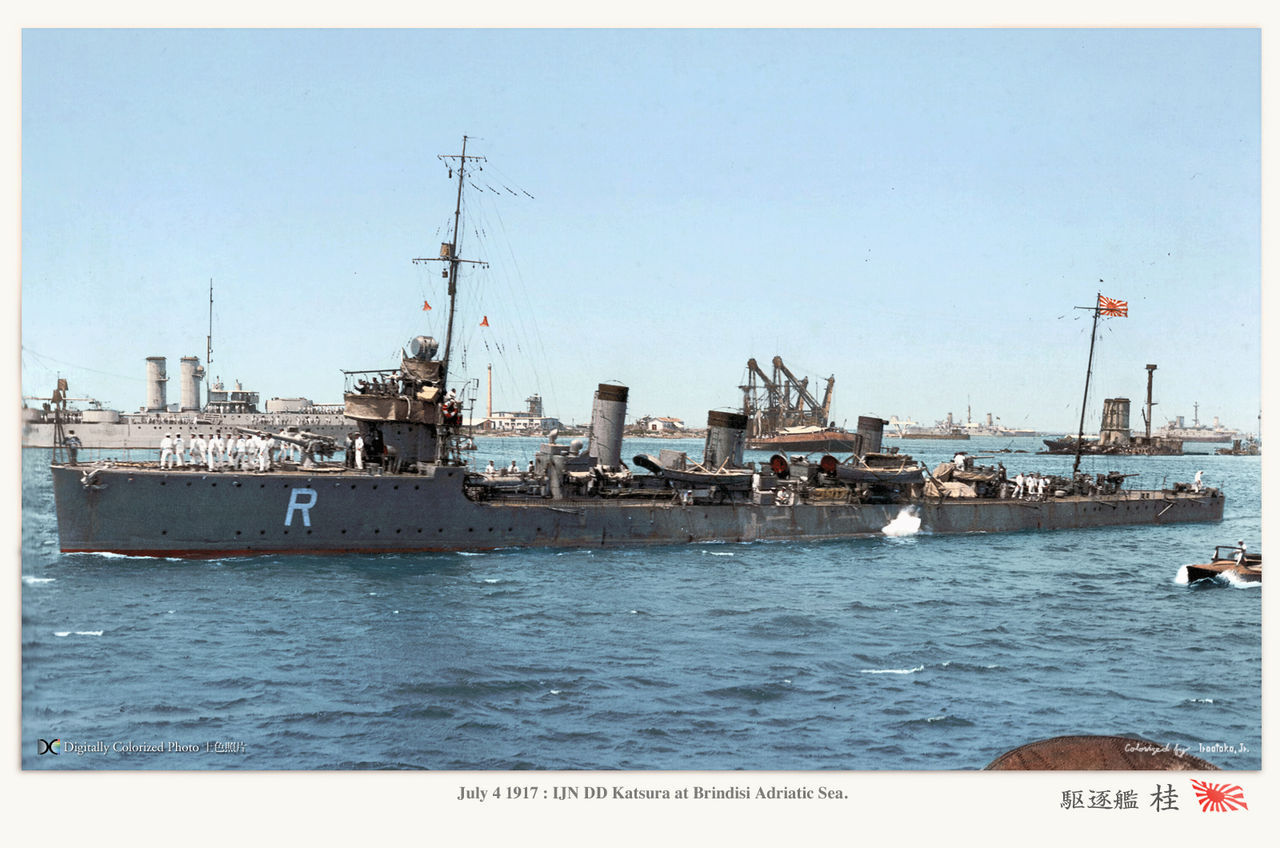
Destroyer Katsura at Brindisi, 1917. Colorized by Irootoko Jr. alias Atsushi Yamashita
Japanese early destroyer design
At last in 1900 the Ten Years Programme put a plan for dozens of new TBs but also ordered 23 destroyers.
The following classes consisted in the Ikazuchi (6), Murakumo (6), Akatsuki (2), Shirakumo (2), Harusame (7), Asakaze (32), Umikaze (2), Sakura (2), and three ex-Russians. These ships were 275 to 375 tonnes, 63 to 69m long, 5.96 to 6.57m of width, 1.56 to 1.83m of draught, 29 to 31 knots and the same armament of 2x 12 pdr, 4x 6pdr and 2 18 in TTs (450 mm).
Ikazuchi were basically Yarrow ships (like the Akatsuki), Murakumo were from Thornycroft, while the Harusame were all Japanese, after a modified Shikarumo design. Their machinery was still very Thornycroft-esque in style. These 1st generation destroyers were all scrapped in 1920. But the second generation was far more interesting and for the most, was in service in the whole interwar and for many, WW2 as well.
Ikazuchi class (6 ships, 1899)
Yarrow-built, completed 1898-1900. Comprised the Akebono, Ikazuchi, Inazuma, Niji, Oboro and Sazanami. 305 tons, 6000 hp, 31 knots. Few participated in the great war: the Niji, scarcely received and perhaps badly manoeuvred by her crew was carried by her own speed and ran aground on a reef. She was salvaged and broken up in 1900, following her only sortie. Ikazuchi was in Tsushima and survived the Russian fire, saw his boiler explode in 1913 and was lost. The Inazuma crashed into a schooner near Hakodate in 1909 and sank it. The Sazanami was also the victim of an accident in 1913. Only the Akebono and Oboro participated in the great war. They became tankers in 1918 and were removed from the lists in 1921.

Murakumo class (6 ships, 1898)
Thornycroft boats, 275 tons (63 x 5.9 x 1.7m), fitted with more powerful machinery to reach 30 knots for 5800 hp. The class Comprised the Murakumo, Shinonome, Shiranu, Usugumo, Yugiri and Kagero.
They were practically built at the same time as the Ikazuchi at Yarrow. They were differentiated by smaller dimensions and a reduced displacement of 305 to 275 tons, and less power available. The Shinonome was hit hard by the first typhoon that almost caused its destruction, but was repaired and lost in another typhoon in 1913. The Murakumo survived the same typhoon in 1909. The Yugiri was almost destroyed in Tsushima, but all participated in the Great War and were removed from the lists between 1921 and 1927.
Akatsuki class (2 ships, 1899)
Virtually repeats of the Ikazuchi, but with boilers giving extra pressure, for 6500 hp (500 hp gain) and 31 knots. 363t boats, same lenght and width but greater draught. Akatsuki and Kasumi were launched and completed 1901-1902.
Shirakumo class (2 ships, 1901)
Japanese design, slimmer and lighter (thus faster) than the following design (see below). Comprised the Shirakumo and Asashio.
Harusame class (7 ships, 1901)
These first 100% Japanese destroyers were derived from the Shirakumo class, which only counted two ships. The class comprised the Shirakumo and Asashio. Both were Japanese-designed, still with some British influence. The Shirakumo were 342 tonnes, 65.8m long 6.34 m wide, whereas the Harusame were substantially larger and wider, while keeping the same draught and different engines. However performances of the former were better, their VTE engines (extra boiler) being able to develop 7000 hp for a reduced weight (33 tons less).

Externally they shared the same silhouette: Long, slim hull with a front turtleback, small platform above the armoured conning tower with the 12 pdr gun and backup bar, command and observation devices. The two single tubes were behind the serie of four funnels squared by the four 57 mm guns while the 75 mm was at the rear end;
Armament comprised the standard two 60mm (12 pdr, four QF 47 mm (6pdr) and two 457 mm torpedo tubes. The class launched 1902-1905 and completed from 1093 to 1905 comprised the Arare, Ariake, Fubuki, Harusame, Hayatori, and Murasame.
In 1905 they all fought in Tsushima. The Harusame was severely damaged by Russian fire and managed to survive. She was lost in 1911 in a typhoon. Hayatori was blown up on a mine during the blockade of Port Arthur. So 5 the units left participated in the Great War, being subsequently deleted from active lists in 1922-24-25.
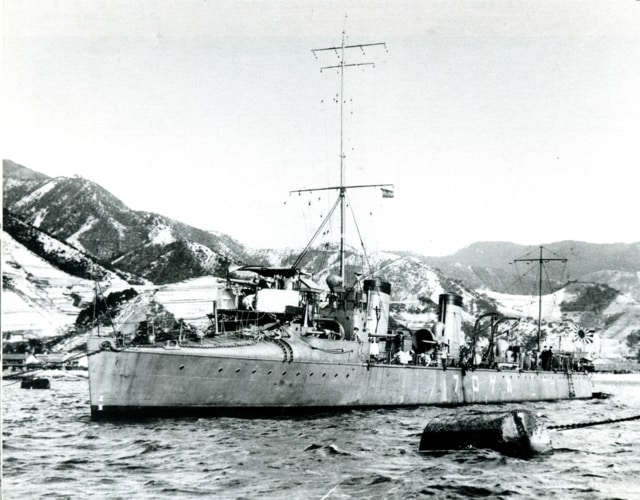
2nd class destroyer Isononome.
All these 24 ships were active (home waters) and retired from service in 1920. They mostly built knowledge and expertise from these different designs that help creating a larger, second generation destroyers.
| Harusame specifications | |
| Dimensions | 69.2 x6.57 x1.83 m |
| Displacement | 375 T FL |
| Crew | 55 |
| Propulsion | 2 shafts VTE engines 6000 hp |
| Speed | 29 knots (55.58 km/h; 34.53 mph) |
| Armament | 2x 12 pdr, 4x 6pdr, 2x 18 in TTs (457 mm). |
Asakaze class (32 ships, 1905-1907)
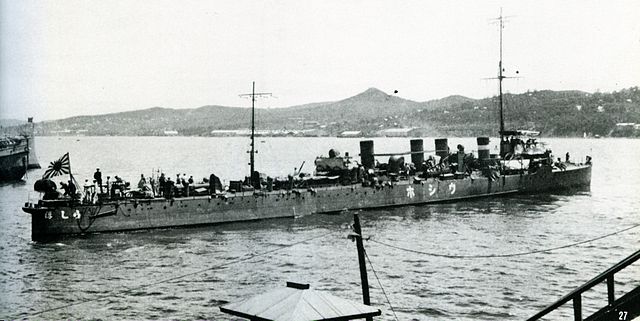
IJN Ushio at Vladivostok
Still 1st generation destroyers, they were the first mass-produced Japanese destroyers. They looked very much like copies of the previous Harusame, as part of an “emergency plan”, 1904 special war programme ordered in June, September 1904 and 1905. Following this, there were attempts to devise oceanic types, but budget and time constraints had the Navy adopting a double standard, with medium (2nd class types) like these ones, fit for coastal water. They indeed participated in WW1 as a defence fleet and were all broken up in 1923-1930, some being converted as minesweepers in between.

The Asakaze were substantially larger than the previous ships, displacing 381 tonnes for 450 at full load, 72 m long, but only lightly larger (4 cm), and the same draught. They derived from a previous Thornycroft design. They had two shafts with 4-cylinder vertical watertubes engines, four Kampon boilers which produced a total of 6000 hp, and the same 29 knots as above. Armament was heavier, with improved guns, two 3.1 in/40 (80 mm), and four 3.1/28 calibers, and like previous classes, two single 457 mm (18 in) centerline torpedo tubes. Complement was also larger, 70 men.
For the first time, Yokosuka could not fulfill the order, which was passed to civilian yards, gaining experience in that area. But because this was a first, some yards had troubles getting the construction right in time, and meny of these ships were launched in 1906, as the design was already obsolete. Ships that were rearmed as minesweepers get two 4.7 in/45 guns and two 3.1in/40 guns for earlier classes.
| Asakaze specifications | |
| Dimensions | 72 x6.6 x1.83 m |
| Displacement | 381 T FL |
| Crew | 70 |
| Propulsion | 2 shafts VTE engines 6000 hp |
| Speed | 29 knots |
| Armament | 2x 3.1/40, 4x 3.1/28 in, 2x 18 in TTs (457 mm). |
Umikaze class (2 ships, 1911)

This was the first oceanic class of destroyers designed and built in Japan, at Maizuru NyD and Mitsubishi (Nagazaki) Naval yard. This design call D-9 were ordered in 1907 as a “proof of concept” in modern standards, but they were only launched in 1909, their blueprints being redrawn and modified in between. First, they were given powerful turbines, Parsons designs built by Mitsubishi, three of them, each one connected to a single shaft, the lot fed by 8 Kampon boilers, for a whooping total of 22,500 hp, enough to reach 33 knots. These were mixed boilers, so 250 tons of coil and 178 tons of oil were stored on board, which gave a range of about 2700 nautical miles at 15 knots.

Complement was double than previous ships, and armament comprise two light cruiser size 4.7 in guns (120 mm) of 40 calibers, and five 3.1 in (80 mm)/40, and two twin 457 mm (18 in) TTs on the Umikaze, whereas Yamakaze had three single tubes. They were delivered only in March 1910 and January 1911 due to delays or delivering the turbines. Their armament was reduced when converted as minesweepers in 1930. Both were stricken in 1936 and broken up. The design was expensive and the next oceanic class was scaled down.
| Umikaze specifications | |
| Dimensions | 98.5 x8.5 x2.7 m |
| Displacement | 1030/1150 T FL |
| Crew | 140 |
| Propulsion | 3 shafts Turbines, 8 boilers 20500 hp |
| Speed | 33 knots |
| Armament | 2x 4.7in, 5x 3.1 in, 4x 18 in TTs (457 mm). |
Wartime Production
The war production was not at the level of those of the RN and the USA: In the 10 Kaba, succeeded the 4 Momo, the 6 Enoki, the 4 Isokaze, the 2 Urakaze, the 2 Tanikaze. 28 destroyers in total. All saw the conflict. On the other hand, the 1918 plan tried to catch up with the allied navies, seeing the construction from 1919 to 1924 of the Minekaze, Momi, Wakatake and Kyokaze/Kamikaze classes, all impressive oceanic destroyers that will actively participate in WW2.
Sakura class (2 ships, 1914)
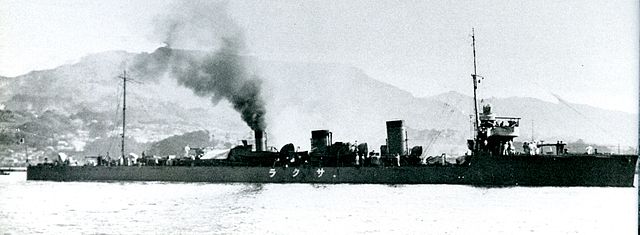
Sakura at Sasebo, Taisho, 1918
The Sakura inaugurated a new category of “second class” destroyers, more economical than the “first class”. They were clearly out of the initial program, including only ocean-going ships of the Umikaze type (1910), and were commissioned mainly for budgetary reasons. The Sakura and the Tachibana were thus lighter than 400 tons, but also less slower.
They were good compromises between the coastal destroyers of the Asakaze type and previous ones coming from Yarrow and the ambitious Umikaze. They were followed by the Kaba class in 1915, 10 heavier units of 60 tons with a larger draft.
| Sakura specifications | |
| Dimensions | 83,6 x 7,3 x 2,3 m |
| Displacement | 665t – 850t T FL |
| Crew | 92 |
| Propulsion | 3 shafts, 3 VTE, 4 kampon boilers, 9500 hp. |
| Speed | 30 knots |
| Armament | 1x 4.7in, 4x 3.1in, 4x 18 in TTs (457 mm). |
Kaba class (11 ships, 1915)
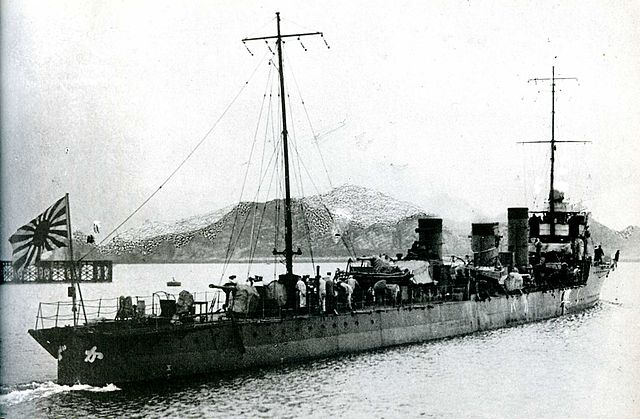
Kaba departing departing Ryojun, 1925
When the was broke out, Japan had only two modern destroyers for oceanic deployment, the Sakura and Tachibana, so the government approved the Emergency Naval Expansion Budget FY1914 and ten more destroyers had to be built in 8 different civilian yards with conventional coil boilers and VTE engines (also to speed up things) rather than turbines. They were indeed laid down in the end of 1914 and launched in early 1915, completed just 1-2 month after and all named after trees.
This Kaba class was so successful that the French ordered 10 more for their own fleet in the Mediterranean, the “Arabe”, all named after peoples living in French colonies. All the Kaba were all removed from service in the 1932.
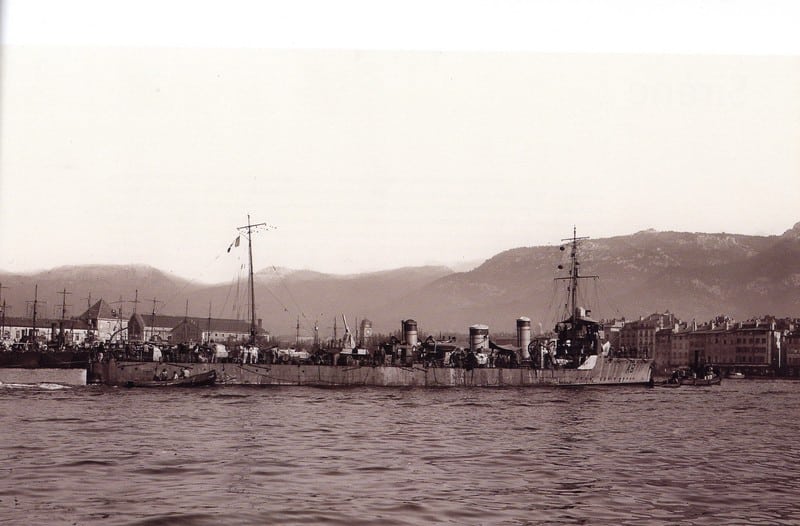
Arabe type destroyer, 1917

| Kaba specifications | |
| Dimensions | 83,6 x 7,3 x 2,3 m |
| Displacement | 665t – 850t T FL |
| Crew | 92 |
| Propulsion | 3 shafts, 3 VTE, 4 kampon boilers, 9500 hp. |
| Speed | 30 knots |
| Armament | 1x 4.7in, 4x 3.1in, 4x 18 in TTs (457 mm). |
Urakaze class (2 ships, 1915)
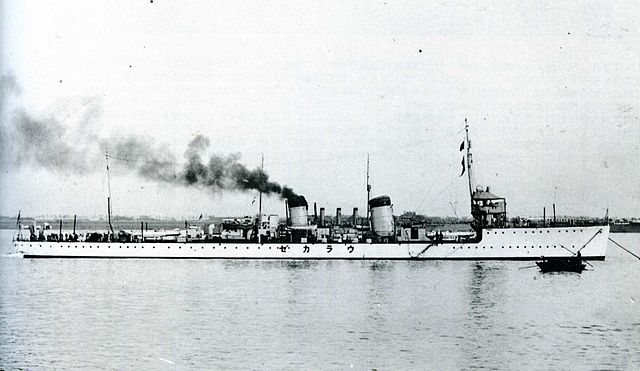
Urakaze at Wuhan, China in 1930-1933
Urakaze and Kawakaze were built in Yarrow, a first since the beginning of the century. They were designed to test new 533 mm torpedo tubes and oil-fired turbines. The kawakaze was, however, awarded by the British government to the Italians even before its completion. The name will be carried by the second building of the Tanikaze class in 1918. The Urakaze, ordered in 1912, saw its construction delayed and it will be finally delivered only in 1919. It will serve a long service until 1936, and its hull will be cast by a US Navy aircraft in 1945.
| Urakaze specifications | |
| Dimensions | 87,2 x 8,4 x 2,4 m |
| Displacement | 907t – 1089t FL |
| Crew | 120 |
| Propulsion | 2 shafts, 2 Curtis turbines, 3 Yarrow boilers, 22 000 hp |
| Speed | 30 knots |
| Armament | 2x 4.7in (120), 4x 3.1in (80), 4x 21 in TTs (533 mm). |

Isokaze class (4 ships, 1916)
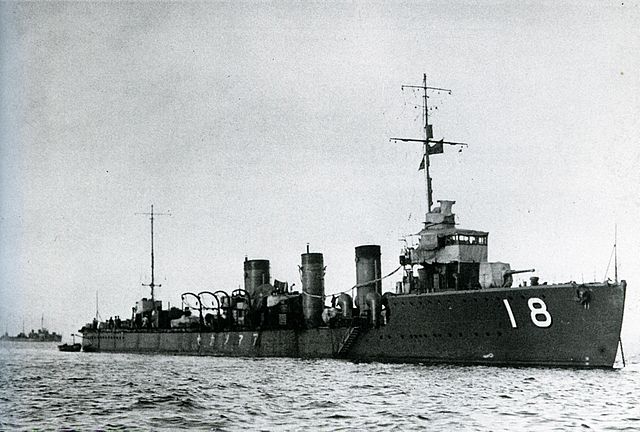
Japanese destroyer Amatsukaze on patrol in Yangzi River, China
The Isokaze class included the Isokaze, Amatsukaze, Hamakaze and Tokitsukaze. They were launched and completed in 1916-17. They were ranked first-class destroyers, and derived from the 1910 Umikaze, as “squadron leaders.” They were much heavier (400 tons) and larger, and gave up their secondary artillery for two additional TTs. In 1935, they were all removed from the lists and broken up in 1936.

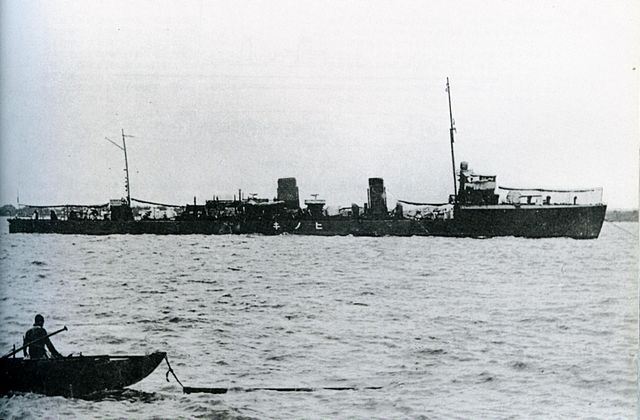
Hinoki at Wuhan
| Isokaze specifications | |
| Dimensions | 96,9 x 8,5 x 2,8 m |
| Displacement | 1227t – 1570t FL |
| Crew | 128 |
| Propulsion | 3 shafts, 3 Parsons/Curtis turbines, 5 kampon boilers, 30 000 hp |
| Speed | 33 knots |
| Armament | 4x 4.7in (120), 6x 18 in TTs (457 mm). |
Momo class
The four Momo (Kashi, Hinoki, Yanagi, Momo), completed in 1916-17 were built in parallel to the Isokaze, with some specific characteristics for the second-class destroyers they were, compared to the Kaba and Sakura. They were the first to showcase an inverted curved bow, specifically Japanese, whose ice-breaking vocation is not an obvious fact, especially turbines and triple torpedo tubes.They were sent to the Mediterranean until 1919 and then served until 1935.
The Kashi was transferred to the marine epoch of the Mandchuko under the name of hai Waei in 1937 and returned to service in Japan in 1943 under the name Kali, before being blasted in Okinawa. The Yanagi was used for training and was broken up only in 1947. The six Enoki (Enoki, Nara, Kuwa, Tsubaki, Maki and Keyaki) were derived from it closely and were launched and finished in 1918. They were slightly heavier and more powerful. They were removed from the lists in 1932 and 1938 for two of them, transformed into minesweepers.

| Dimensions | 58,8 x 7,7 x 2,3 m |
| Displacement | 875t-1080t T FL |
| Crew | 110 |
| Propulsion | 2 shafts, 3 Curtis turbines, 4 kampon boilers, 16 000 hp |
| Speed | 31.5 knots |
| Armament | 3x 4.7in, 3x 7.7mm MGs, 6x 18 in TTs (457 mm). |
Enoki class (6 ships, 1918)
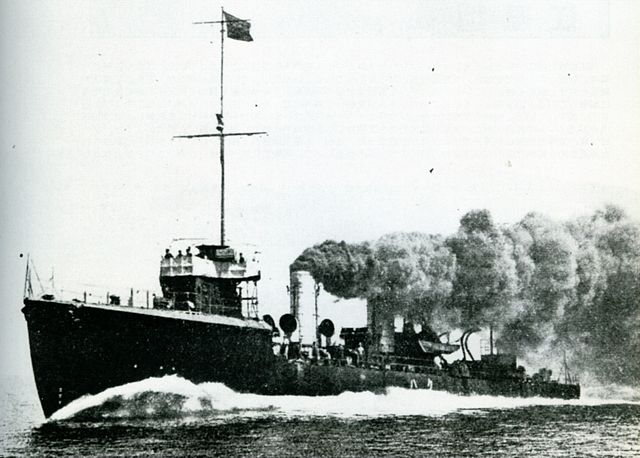
Kuwa in trials in 1918 off Yokosuka
All named after trees, these six destroyers were part of the FY1917 emergency procurement budget, bound to operate in the Mediterranean. They were all laid down in 1917 and completed in 1918, built in Yokosuka Naval Arsenal, but also Kure, Sasebo and Maizuru naval arsenals. They were virtually repeates of the previous Momo (same blueprints) but were modified with a new bow and better armour. In general experience dictated their hull to be strengthened to handle heavy seas. For propulsion their relied on proven Brown-Curtis geared steam turbine engines coupled with mixed-fired boilers. Armament was also identical to the Kaba, with three QF 4.7 inch Gun Mk I – IV guns and triple TT banks. Due to their very late arrival, these ships were never deployed in their intended destination and instead spent their career near the Japanese home islands. Two were converted as minesweepers in 1930. They were all retired in 1934-36.
Specs are near-identical to the Kaba.
Kawakaze class (2 ships, 1918)

Tanikaze (谷風 “Valley Wind”)
The large destroyer leaders (Kawakaze, Tanikaze, named after winds) were built in Maizuru and Yokosuka, as part the IJN ‘8-4 Fleet Program’ FY1915. Basically they were escort vessels for the new Nagato class battleships and Tenryū class cruisers. One of the two was funded by the Italian government after reception of the Kawakaze (now Audace). These were large ships (1600 tons fully loaded), roomy enough to fit a set of two large shaft steam turbine fed by 4 boilers producing 34,000 ihp (25,000 kW) total, enough to reach a blazing 37.5 knots (69.5 km/h) speed. Armament also comprised the new new Type 3 120 mm 45 caliber naval guns and also new 533 mm three double launchers and AA armament of two 6.5 mm machine guns. Both missed ww1 as Kawakaze was completed in November, 11, 1918 and the second 30 January 1919. They served in the interwar until 1934-35.
Momi class (21 ships, 1919)
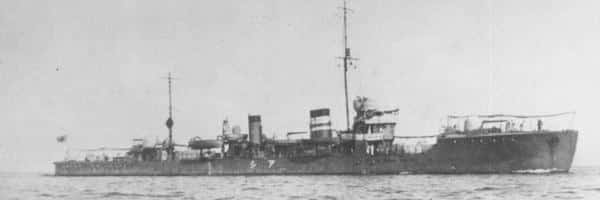
Ashi of the Momi class
These are included in this post and not the following because they has been ordered before the end of the war, part of IJN’s 8-4 Fleet Program FY1918, the lead ship Momi being laid down at Yokosuka on 23 January 1918. Most were launched however from 1919 to 1921 and of 28 ships planned (all named after flowers) 7 were cancelled, 10 scrapped. Most served for the whole interwar and for a few, WW2 (many were decommissioned or converted for other uses in 1940, seen as obsolete). They were built at Yokosuka but also Kure, Fujinagata, Ishikawajima, Kawasaki and Uraga.
They were virtually repeats of the cheap and simple Enoki second-class destroyers, comparable in some ways to Royal Navy corvettes. Their main trade feature like German destroyers was a lengthened forecastle with a break forming immediately forward of the bridge giving protection to the forward bank of torpedo tubes. They used three Kampon oil-fired boilers, and light turbines of the Parsons, Brown-Curtis, Escher Wyss & Cie Zoelly, Mitsubishi, but Kampon turbines for most Consequentely these ships developed 21,500 hp (16,000 kW), enough for their 800 tonnes to reach 36 knots. Their career will be seen in detail in ww2 IJN destroyer post, but in short, 11 were lost in action.

Tsuta as converted as a fast landing ship transport in 1943, notice the Daihatsu barge and modified stem.
Wakatake class (8 ships, 1922)
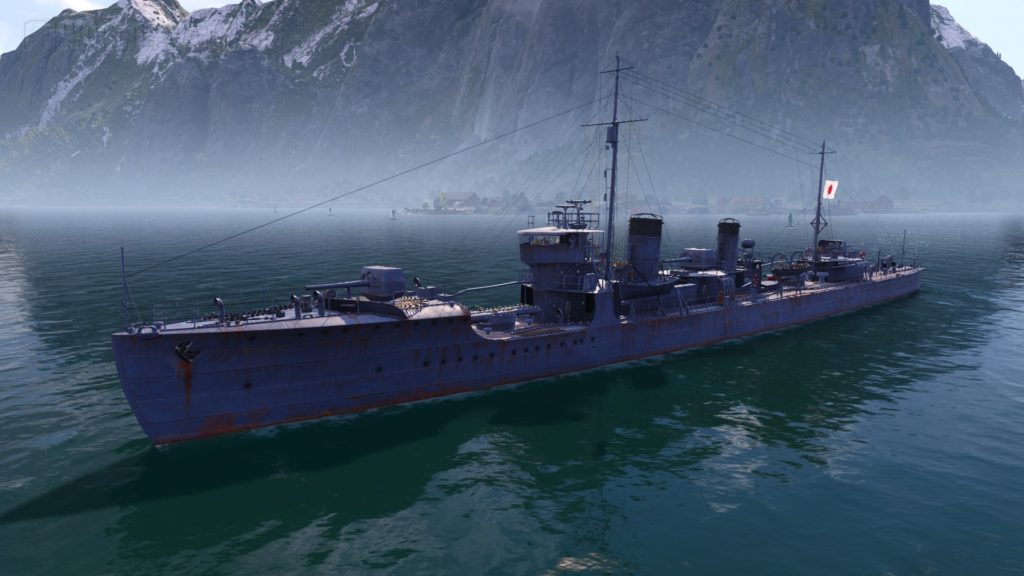
(To Come)
Minekaze class (16 ships, 1919-22)
First class destroyers (1345 tonnes). All in service in WW2
(To Come)
Kamikaze class (9 ships, 1922-24)
First class destroyers (1400 tonnes). All in service in WW2
(To Come)
Links
Specs Conway’s all the world fighting ships 1921-1947.
https://www.naval-encyclopedia.com/ww1/pages/japan/asakaze.html
https://www.naval-encyclopedia.com/ww1/images/ships/japan/
https://www.naval-encyclopedia.com/ww1/pages/japan/marine_jap1914c.htm


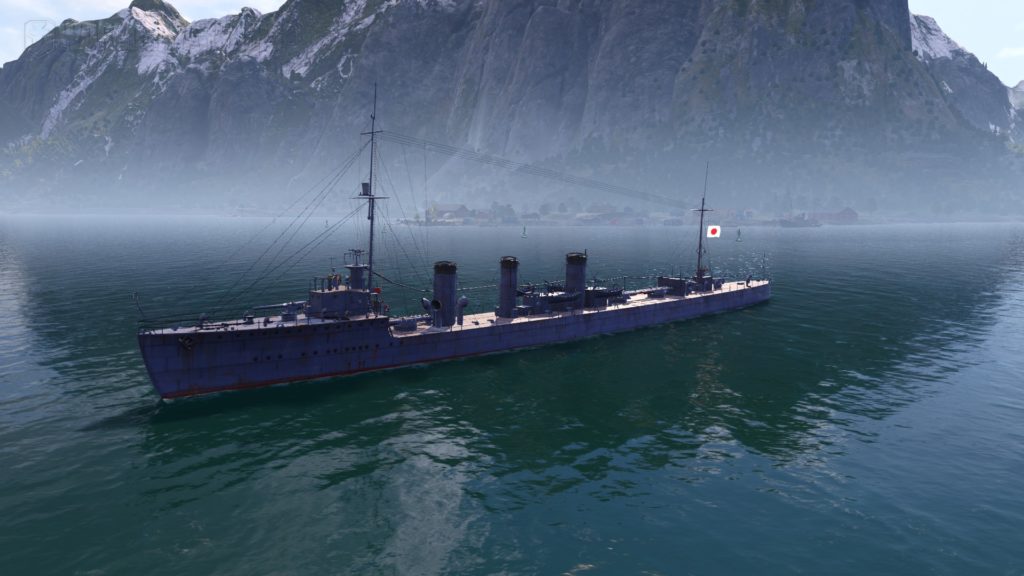
 Latest Facebook Entry -
Latest Facebook Entry -  X(Tweeter) Naval Encyclopedia's deck archive
X(Tweeter) Naval Encyclopedia's deck archive Instagram (@navalencyc)
Instagram (@navalencyc)





 French Navy
French Navy Royal Navy
Royal Navy Russian Navy
Russian Navy Armada Espanola
Armada Espanola Austrian Navy
Austrian Navy K.u.K. Kriegsmarine
K.u.K. Kriegsmarine Dansk Marine
Dansk Marine Nautiko Hellenon
Nautiko Hellenon Koninklije Marine 1870
Koninklije Marine 1870 Marinha do Brasil
Marinha do Brasil Osmanlı Donanması
Osmanlı Donanması Marina Do Peru
Marina Do Peru Marinha do Portugal
Marinha do Portugal Regia Marina 1870
Regia Marina 1870 Nihhon Kaigun 1870
Nihhon Kaigun 1870 Preußische Marine 1870
Preußische Marine 1870 Russkiy Flot 1870
Russkiy Flot 1870 Svenska marinen
Svenska marinen Søværnet
Søværnet Union Navy
Union Navy Confederate Navy
Confederate Navy Armada de Argentina
Armada de Argentina Imperial Chinese Navy
Imperial Chinese Navy Marinha do Portugal
Marinha do Portugal Mexico
Mexico Kaiserliche Marine
Kaiserliche Marine 1898 US Navy
1898 US Navy Sovietskiy Flot
Sovietskiy Flot Royal Canadian Navy
Royal Canadian Navy Royal Australian Navy
Royal Australian Navy RNZN Fleet
RNZN Fleet Chinese Navy 1937
Chinese Navy 1937 Kriegsmarine
Kriegsmarine Chilean Navy
Chilean Navy Danish Navy
Danish Navy Finnish Navy
Finnish Navy Hellenic Navy
Hellenic Navy Polish Navy
Polish Navy Romanian Navy
Romanian Navy Turkish Navy
Turkish Navy Royal Yugoslav Navy
Royal Yugoslav Navy Royal Thai Navy
Royal Thai Navy Minor Navies
Minor Navies Albania
Albania Austria
Austria Belgium
Belgium Columbia
Columbia Costa Rica
Costa Rica Cuba
Cuba Czechoslovakia
Czechoslovakia Dominican Republic
Dominican Republic Haiti
Haiti Hungary
Hungary Honduras
Honduras Estonia
Estonia Iceland
Iceland Eire
Eire Equador
Equador Iran
Iran Iraq
Iraq Latvia
Latvia Liberia
Liberia Lithuania
Lithuania Mandchukuo
Mandchukuo Morocco
Morocco Nicaragua
Nicaragua Persia
Persia San Salvador
San Salvador Sarawak
Sarawak Uruguay
Uruguay Venezuela
Venezuela Zanzibar
Zanzibar Warsaw Pact Navies
Warsaw Pact Navies Bulgaria
Bulgaria Hungary
Hungary

 Bundesmarine
Bundesmarine Dutch Navy
Dutch Navy Hellenic Navy
Hellenic Navy Marina Militare
Marina Militare Yugoslav Navy
Yugoslav Navy Chinese Navy
Chinese Navy Indian Navy
Indian Navy Indonesian Navy
Indonesian Navy JMSDF
JMSDF North Korean Navy
North Korean Navy Pakistani Navy
Pakistani Navy Philippines Navy
Philippines Navy ROKN
ROKN Rep. of Singapore Navy
Rep. of Singapore Navy Taiwanese Navy
Taiwanese Navy IDF Navy
IDF Navy Saudi Navy
Saudi Navy Royal New Zealand Navy
Royal New Zealand Navy Egyptian Navy
Egyptian Navy South African Navy
South African Navy






























 Ukrainian Navy
Ukrainian Navy dbodesign
dbodesign